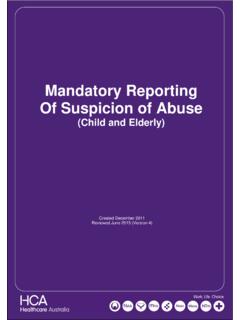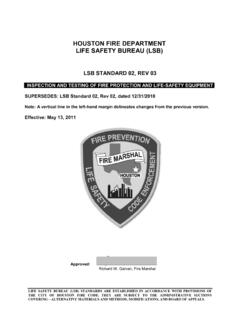Transcription of Emergency Procedures Fire Safety - Healthcare Australia
1 Emergency Procedures &. fire Safety February 2013 (Version 4). Level 1 Document Emergency Procedures & fire Safety This course is endorsed by APEC No 061122359. as authorised by Australian College of Nursing (ACN) according to approved criteria. Attendance attracts 1 ACN CNE point as part of ACN's Life Long Learning Program (3LP). (Equivalent to 1 hour CPD). Created by: NEU Page 2 of 16 fire & Emergency Procedures Online Tutorial Package Initial date: September 2009 Version 4 February 2013. Printed copies of this document are not controlled. Refer to the HCA intranet to ensure that this is the current version. Level 1 Document Objective of Education Package After identification of their own learning needs the employee will be able to show evidence of theoretical knowledge of Emergency Procedures and fire Safety Training. This tutorial is designed to provide an overview to Emergency codes and fire Safety in Australia .
2 After proceeding through this online tutorial the participant should have understanding of the basic concepts of fire prevention, the use of fire equipment and fire system awareness, fire Emergency response Procedures and evacuation, and the Emergency Procedure Guide. This tutorial is designed as a generic learning tool in which all levels of nursing and health care workers can exit with the same learning experience. However, Healthcare workers have the responsibility for making themselves aware of the specific policies and protocols where they work as equipment and conditions vary. Remember: There are many textbooks and websites that you can access if at the end of this tutorial, you, as an individual working in the Healthcare industry, recognise a need for more learning in this area and, as such, it is your obligation to do so. Created by: NEU Page 3 of 16 fire & Emergency Procedures Online Tutorial Package Initial date: September 2009 Version 4 February 2013.
3 Printed copies of this document are not controlled. Refer to the HCA intranet to ensure that this is the current version. Level 1 Document Chemistry of fire : The fire Triangle fire starts when Fuel (a flammable and/or combustible material) has an adequate supply of Oxygen and is subjected to enough Heat. A fire cannot exist without these three elements FUEL + OXYGEN + HEAT. Therefore, fire can also be extinguished by removing any one of these three elements. For example: Removal of HEAT through the application of water via a hose;. Removal of OXYGEN through application of carbon dioxide to starve the fire of O2;. Removal of FUEL through use of bins etc., to keep rubbish contained. Health Facilities fire Protection Systems 1. Each Health Facility, you are employed in will have Policies & Procedures at the local level. These Policies & Procedures have been developed to guide you in the event of a work place hazard occurring.
4 It is up to the individual to have knowledge of these local Policies & Procedures ;. 2. All Health Facilities will have heat and smoke detectors;. 3. All Health Facilities should have a Break Glass Alarm' within its environment and an internal alarm system;. 4. Most Health Facilities have fire and/or smoke rated doors;. 5. All Health Facilities will have a selection of fire fighting equipment canvas hose reels (for use of fire Department); fire extinguishers; fire blankets, fire hose reels;. 6. All Health Facilities will have a maintenance system of all its equipment on a annual basis;. 7. All Health Facilities will have a training/education program for their staff. Created by: NEU Page 4 of 16 fire & Emergency Procedures Online Tutorial Package Initial date: September 2009 Version 4 February 2013. Printed copies of this document are not controlled. Refer to the HCA intranet to ensure that this is the current version.
5 Level 1 Document Identification & Operation of fire Fighting Equipment fire Extinguishers There are 4 basic steps to remember when using a fire extinguisher: Pull the pin at the top of the extinguisher Aim the nozzle towards the base of the fire P-A-S-S. Squeeze the handles together Sweep the nozzle from side to side, directing the contents at the base of the flames. Classes of fire Differing fire Extinguishers and Profiles Class A Paper, textiles, wood, most plastics & rubber Class B Flammable liquids Class C Combustible gases Class E Electrically energised equipment Water Extinguisher Wood, paper, plastic, textiles & rubber. Created by: NEU Page 5 of 16 fire & Emergency Procedures Online Tutorial Package Initial date: September 2009 Version 4 February 2013. Printed copies of this document are not controlled. Refer to the HCA intranet to ensure that this is the current version. Level 1 Document Foam Extinguisher Wood, paper, plastic, rubber & flammable liquids.
6 Dry Chemical /Powder Extinguisher Wood, paper, plastics, rubber, flammable liquids, combustible gases & electrical energised equipment. Powder fire Extinguisher ABE. (distinguished by a WHITE band around the top of the cylinder). The most widely used type of fire extinguisher suited for fires occurring in the house, boat, garage, car or caravans. Carbon Dioxide Electrical fires Flammable liquids Note: the differing profile of nozzle in the cylinder. Created by: NEU Page 6 of 16 fire & Emergency Procedures Online Tutorial Package Initial date: September 2009 Version 4 February 2013. Printed copies of this document are not controlled. Refer to the HCA intranet to ensure that this is the current version. Level 1 Document fire Blankets fire Blankets are to only used on a small fire ;. Protect yourself from the flames by shielding your body with the blanket. Look over the blanket and approach the fire keeping it at arm's length.
7 Place (do not throw) the blanket over the container to completely smother the fire . Make sure that the blanket has completed a seal around the rim of the container;. Back away from the fire to a safe distance;. Dispose of the blanket after use. DO NOT RE-USE. fire Hose Reel Open valve ( ensure that hose reel is turned off at nozzle). Run out hose towards scene of fire Open nozzle and direct stream at base of fire Usually connected to main water system but not the canvas reels that are used by the fire brigade. Action in the Event of fire or Smoke in a Hospital Remove people from the immediate area if safe to do so;. Alert switch (dial Emergency no.) or the fire Brigade (break glass alarm);. Contain if practicable, close the doors . Extinguish use appropriate fire -fighting equipment but do not take risks. Evacuate to a safe area if and when directed to do so, ensuring that you can account for everybody under your care.
8 Created by: NEU Page 7 of 16 fire & Emergency Procedures Online Tutorial Package Initial date: September 2009 Version 4 February 2013. Printed copies of this document are not controlled. Refer to the HCA intranet to ensure that this is the current version. Level 1 Document Action in the Event of an Alarm Check your immediate area for any sign of smoke, fire or a red light showing on a detector;. If safe to do so, proceed to the Nurses station and place patient records in a pillow case but only if safe to do so. Check for smoke or fire as you proceed and make sure that fire doors and windows are closed;. Listen for any messages over the PA (Public Address) system;. If directed to evacuate - Evacuate to a safe area when directed to do so ensuring that you can account for everybody under your care and if possible take records with you;. Remember the format if you discover fire or smoke. Emergency Procedure Guides The Emergency Procedure Guide is found in a flip chart booklet Guides outline the core actions required in the events of an incident They should be located in all areas of hospitals/health settings They should be located near the hospital/health setting Emergency number Emergency Codes The Guides are colour coded as follows: Medical Emergency Code Blue Bomb Threat Code Purple Internal Emergency Code Yellow Personal threat Code Black External Emergency Code Brown Evacuation Code Orange fire /Smoke Code Red Created by: NEU Page 8 of 16 fire & Emergency Procedures Online Tutorial Package Initial date: September 2009 Version 4 February 2013.
9 Printed copies of this document are not controlled. Refer to the HCA intranet to ensure that this is the current version. Level 1 Document Emergency Response fire & Smoke CODE RED. The presence of smoke or fire is a CODE RED. If you discover a CODE RED you should: Remain calm;. Dial the hospital Emergency number and state: o there is a CODE RED', o The exact location o Your name & title In the event of a fire in a hospital you are to follow Medical Emergency CODE BLUE. Code Blue - Medical Emergency All HCA employees need to access Basic Life Support on line package, to fully familiarize yourself with your role during a CODE BLUE. This is a synopsis only: Danger Ensure your own, then others Safety remove danger. Response Assess the person by touching gently, talking, or asking are you OK?'. Send for help If in a patient's room, push the Emergency Call Button, or attract the attention of a second person if available.
10 Dial Emergency number & state: o There is a cardiac arrest o The exact location, ward, room number A Check airway B Check breathing C Commence Cardiac Compressions D Defibrillate patient via Automated External Defibrillator Always stay with the person until help arrives if at all possible. Created by: NEU Page 9 of 16 fire & Emergency Procedures Online Tutorial Package Initial date: September 2009 Version 4 February 2013. Printed copies of this document are not controlled. Refer to the HCA intranet to ensure that this is the current version. Level 1 Document In some of the larger hospital settings throughout Australia before a patient requires a Code Blue Arrest call to be made, a Medical Emergency Team (MET) can be called if the patient's condition is deteriorating - but check with your health facility for further information. Bomb Threat CODE PURPLE. Code Purple - Bomb Threat If you receive a telephone threat you should: Remain calm & listen take notes if possible or use Bomb Threat Checklist' if this is readily available.













